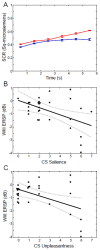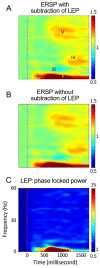Behavioral, Physiological and EEG Activities Associated with Conditioned Fear as Sensors for Fear and Anxiety
- PMID: 33255916
- PMCID: PMC7728331
- DOI: 10.3390/s20236751
Behavioral, Physiological and EEG Activities Associated with Conditioned Fear as Sensors for Fear and Anxiety
Abstract
Anxiety disorders impose substantial costs upon public health and productivity in the USA and worldwide. At present, these conditions are quantified by self-report questionnaires that only apply to behaviors that are accessible to consciousness, or by the timing of responses to fear- and anxiety-related words that are indirect since they do not produce fear, e.g., Dot Probe Test and emotional Stroop. We now review the conditioned responses (CRs) to fear produced by a neutral stimulus (conditioned stimulus CS+) when it cues a painful laser unconditioned stimulus (US). These CRs include autonomic (Skin Conductance Response) and ratings of the CS+ unpleasantness, ability to command attention, and the recognition of the association of CS+ with US (expectancy). These CRs are directly related to fear, and some measure behaviors that are minimally accessible to consciousness e.g., economic scales. Fear-related CRs include non-phase-locked phase changes in oscillatory EEG power defined by frequency and time post-stimulus over baseline, and changes in phase-locked visual and laser evoked responses both of which include late potentials reflecting attention or expectancy, like the P300, or contingent negative variation. Increases (ERS) and decreases (ERD) in oscillatory power post-stimulus may be generalizable given their consistency across healthy subjects. ERS and ERD are related to the ratings above as well as to anxious personalities and clinical anxiety and can resolve activity over short time intervals like those for some moods and emotions. These results could be incorporated into an objective instrumented test that measures EEG and CRs of autonomic activity and psychological ratings related to conditioned fear, some of which are subliminal. As in the case of instrumented tests of vigilance, these results could be useful for the direct, objective measurement of multiple aspects of the risk, diagnosis, and monitoring of therapies for anxiety disorders and anxious personalities.
Keywords: Event Related Potential; Event Related Spectral Perturbation; anxiety; expectation; fear; fear conditioning; human; scalp EEG.
Conflict of interest statement
None of the authors has conflicts of interest related to this work. The manuscript is in accordance with the statement of ethical standards for manuscripts submitted to MDPI (Sensors).
Figures





Similar articles
-
Oscillatory EEG activity induced by conditioning stimuli during fear conditioning reflects Salience and Valence of these stimuli more than Expectancy.Neuroscience. 2017 Mar 27;346:81-93. doi: 10.1016/j.neuroscience.2016.12.047. Epub 2017 Jan 8. Neuroscience. 2017. PMID: 28077278 Free PMC article.
-
Expectancy bias in a selective conditioning procedure: trait anxiety increases the threat value of a blocked stimulus.J Behav Ther Exp Psychiatry. 2012 Jun;43(2):832-7. doi: 10.1016/j.jbtep.2011.11.005. Epub 2011 Dec 13. J Behav Ther Exp Psychiatry. 2012. PMID: 22197754
-
Unconditioned response to an aversive stimulus as predictor of response to conditioned fear and safety: A cross-species study.Behav Brain Res. 2021 Mar 26;402:113105. doi: 10.1016/j.bbr.2020.113105. Epub 2021 Jan 6. Behav Brain Res. 2021. PMID: 33417995
-
Impact of observational and direct learning on fear conditioning generalization in humans.Prog Neuropsychopharmacol Biol Psychiatry. 2023 Mar 8;121:110650. doi: 10.1016/j.pnpbp.2022.110650. Epub 2022 Sep 29. Prog Neuropsychopharmacol Biol Psychiatry. 2023. PMID: 36181957
-
Contextual modulation of conditioned responses in humans: A review on virtual reality studies.Clin Psychol Rev. 2021 Dec;90:102095. doi: 10.1016/j.cpr.2021.102095. Epub 2021 Oct 22. Clin Psychol Rev. 2021. PMID: 34763127 Review.
Cited by
-
Detection of Anxiety-Based Epileptic Seizures in EEG Signals Using Fuzzy Features and Parrot Optimization-Tuned LSTM.Brain Sci. 2024 Aug 22;14(8):848. doi: 10.3390/brainsci14080848. Brain Sci. 2024. PMID: 39199539 Free PMC article.
-
Emotion Self-Regulation in Neurotic Students: A Pilot Mindfulness-Based Intervention to Assess Its Effectiveness through Brain Signals and Behavioral Data.Sensors (Basel). 2022 Apr 1;22(7):2703. doi: 10.3390/s22072703. Sensors (Basel). 2022. PMID: 35408317 Free PMC article.
References
-
- Demyttenaere K., Bruffaerts R., Posada-Villa J., Gasquet I., Kovess V., Lepine J.P., Angermeyer M.C., Bernert S., de Girolamo G., Morosini P., et al. Prevalence, severity, and unmet need for treatment of mental disorders in the World Health Organization World Mental Health Surveys. JAMA. 2004;291:2581–2590. doi: 10.1001/jama.291.21.2581. - DOI - PubMed
-
- Kessler R.C., Avenevoli S., Costello E.J., Georgiades K., Green J.G., Gruber M.J., He J.P., Koretz D., McLaughlin K.A., Petukhova M., et al. Prevalence, persistence, and sociodemographic correlates of DSM-IV disorders in the National Comorbidity Survey Replication Adolescent Supplement. Arch. Gen. Psychiatry. 2012;69:372–380. doi: 10.1001/archgenpsychiatry.2011.160. - DOI - PMC - PubMed
-
- Smit F., Cuijpers P., Oostenbrink J., Batelaan N., de Graaf R., Beekman A. Costs of nine common mental disorders: Implications for curative and preventive psychiatry. J. Ment. Health Policy Econ. 2006;9:193–200. - PubMed
Publication types
MeSH terms
Grants and funding
LinkOut - more resources
Full Text Sources
Research Materials
Miscellaneous

